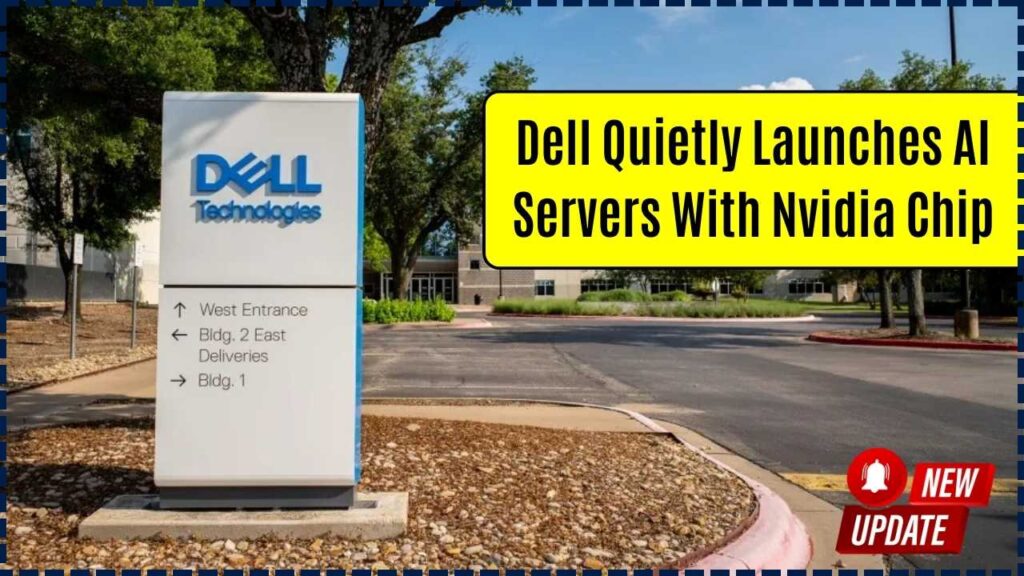Dell Quietly Launches AI Servers With Nvidia Chip: In a significant move for enterprise computing, Dell Technologies has quietly rolled out a powerful lineup of AI servers powered by Nvidia’s latest hardware. The release, which includes servers built on Nvidia’s cutting-edge Blackwell Ultra GPU architecture, is designed to push the boundaries of AI performance for organizations handling large-scale, complex workloads.

While the launch didn’t involve the usual fanfare, the implications are far-reaching. These servers are not just faster—they are designed to redefine efficiency, scalability, and performance in data centers worldwide. Here’s everything you need to know about Dell’s new AI server lineup, what sets them apart, and why this matters to businesses, IT professionals, and the AI community.
Dell Quietly Launches AI Servers With Nvidia Chip
| Feature | Details |
|---|---|
| Launch Models | Dell PowerEdge XE9780, XE9785, XE9780L, XE9785L, XE9712, XE7745 |
| GPU Integration | Up to 192 Nvidia Blackwell Ultra GPUs; scalable to 256 per Dell IR7000 rack |
| Cooling Technologies | Air-cooled and direct-to-chip liquid cooling variants |
| Performance Boost | Up to 4x faster training speeds for large language models (LLMs) |
| Future Support | Compatibility with Nvidia Vera CPUs and Vera Rubin chips |
| Network Stack | Supports Dell PowerSwitch SN5600, SN2201, and Nvidia Quantum-X800 InfiniBand |
| Software Ecosystem | Part of the Dell AI Factory full-stack AI infrastructure |
| Target Audience | Enterprise AI/ML teams, data scientists, research institutions, hyperscalers |
| Official Website | dell.com |
Dell’s latest move in launching AI servers with Nvidia Blackwell chips is a major advancement for the enterprise AI space. These machines are designed for high-impact workloads—from LLM training to real-time data analytics—and are packed with future-ready features like liquid cooling, Vera CPU compatibility, and full-stack integration through the Dell AI Factory.
For IT leaders, CIOs, and AI practitioners, this release is a game-changer, delivering not only performance but also the flexibility and scalability to handle the next wave of AI demands.
Why Dell’s New AI Servers Matter
AI workloads are growing rapidly, both in size and complexity. Models like GPT-4, Gemini, and Claude require massive computational power for training and inference. Dell’s new PowerEdge AI servers are purpose-built to handle such intensive demands. These machines are designed with enterprise readiness in mind—focusing on flexibility, power efficiency, and scalability.
Dell’s integration with Nvidia’s latest Blackwell Ultra chips ensures that organizations have access to the most advanced AI computing architecture available today. For context, Nvidia’s Blackwell architecture is optimized for transformer models, deep learning, generative AI, and real-time analytics.
A Closer Look at Dell’s PowerEdge Lineup
PowerEdge XE9780 & XE9785
These high-end systems are equipped with up to 8 Nvidia GPUs and Intel Xeon processors. They are designed for organizations training large language models (LLMs), running simulations, or operating high-density AI deployments.
- Supports Nvidia NVLink for ultra-fast GPU communication
- Works with Nvidia H100 and Blackwell GPUs
- Ideal for AI research labs and hyperscalers
PowerEdge XE9780L & XE9785L
These liquid-cooled versions are built for organizations needing energy efficiency and space optimization. Direct-to-chip cooling helps reduce power consumption while maintaining high performance.
- Delivers better thermal efficiency in dense racks
- Helps data centers meet environmental and sustainability goals
- Supports next-gen GPU thermal envelopes
PowerEdge XE9712 and XE7745
These servers are aimed at customers needing high-density GPU clustering and HPC + AI hybrid workloads.
- Configurable for inference, data analytics, and edge computing
- Built for scale-out environments and multi-node GPU training setups
Built for Tomorrow: Nvidia Vera and Vera Rubin
Dell’s new servers are future-proof, with compatibility for upcoming Nvidia Vera CPUs and Vera Rubin chips. These chips are expected to offer new levels of AI-native performance, integrating CPU/GPU functionality in more seamless and power-efficient ways.
Enterprises investing in Dell infrastructure today can stay ahead of the curve without needing complete hardware overhauls every 12–18 months. This long-term flexibility is a major win for CIOs and data center architects.
Smarter Cooling for Greener Operations
Thermal efficiency is no longer just about performance—it’s about sustainability. Dell’s decision to launch both air- and liquid-cooled server versions is a nod to the industry’s push toward energy-efficient AI infrastructure.
- Air cooling works for traditional rack setups and predictable workloads.
- Liquid cooling is ideal for dense clusters and GPU-heavy models like LLMs.
- Reduced energy consumption lowers TCO and aligns with ESG targets.
This dual option ensures organizations can choose the right solution based on their infrastructure, climate, and carbon reduction strategies.
The Dell + Nvidia AI Factory
These servers are part of the Dell AI Factory—an ecosystem created in partnership with Nvidia. It includes hardware, software, tools, and professional services to help enterprises:
- Build, train, and deploy AI models faster
- Manage datasets efficiently
- Monitor GPU usage and optimize AI workflows
- Integrate with Kubernetes, VMware, and hybrid cloud setups
This end-to-end approach simplifies AI adoption for businesses of all sizes, from startups and universities to global enterprises.
How Dell Quietly Launches AI Servers With Nvidia Chip Compares to the Competition
Dell’s new AI servers position it competitively against rivals like HPE, Lenovo, and Supermicro, who are also racing to support Blackwell GPUs. Key advantages include:
- Tight integration with Nvidia’s AI roadmap
- Broad choice of server models
- Support for liquid and air cooling
- Dell’s enterprise support, security compliance, and global service network
While others focus heavily on hyperscalers, Dell has crafted its offerings to suit mainstream enterprises and verticals like finance, healthcare, and manufacturing.
OnePlus 13 May Replace Alert Slider With New iPhone-Style Button — What to Expect
Apple iPhone 18 Pro May Feature Under-Display Face ID; What You Need to Know Now
Google Gemini 2.5 Pro Preview Debuts With Major Coding and AI Improvements
Use Cases in the Real World
Healthcare:
- Accelerated medical imaging analysis
- AI-assisted drug discovery pipelines
Finance:
- Risk modeling and fraud detection using real-time AI
- High-frequency trading simulations with low-latency performance
Manufacturing:
- Predictive maintenance and quality control
- Real-time robotics vision processing
Academia:
- Training large language and vision models for cutting-edge research
- Shared GPU resources in AI research clusters
These examples highlight just how versatile and impactful these systems can be in a variety of real-orld applications.
FAQs On Dell Quietly Launches AI Servers With Nvidia Chip
Q1. What GPUs do these Dell servers support?
They support Nvidia Blackwell Ultra GPUs, with backward compatibility for H100 and A100.
Q2. Can I customize server configurations?
Yes, configurations are highly flexible and can be tailored based on compute, memory, storage, and cooling needs.
Q3. Are these servers available globally?
Dell’s PowerEdge AI servers are available through its global enterprise and channel partners.
Q4. What OS and software environments are supported?
Linux distributions, Kubernetes, VMware, and AI frameworks like TensorFlow, PyTorch, and NVIDIA AI Enterprise.
Q5. Is liquid cooling safe and reliable?
Yes. Dell’s direct-to-chip liquid cooling is tested for enterprise-grade deployments and is becoming the standard for dense compute environments.






